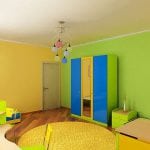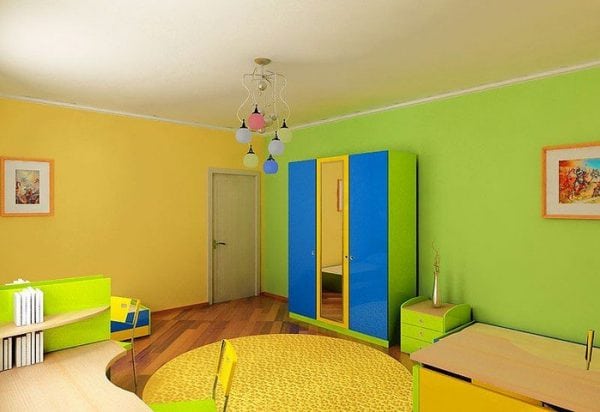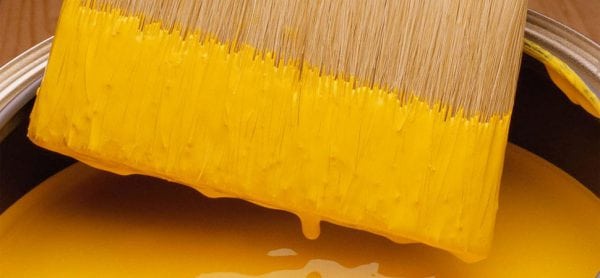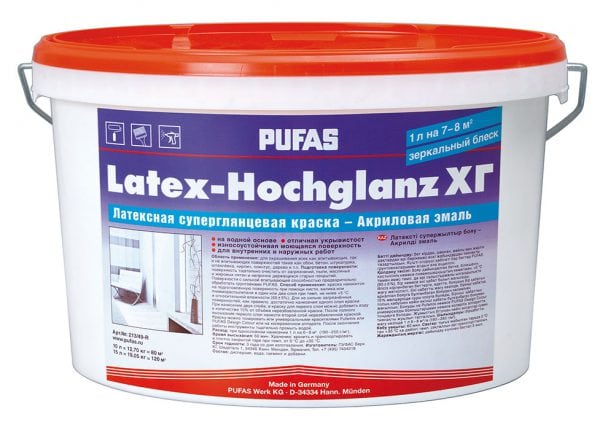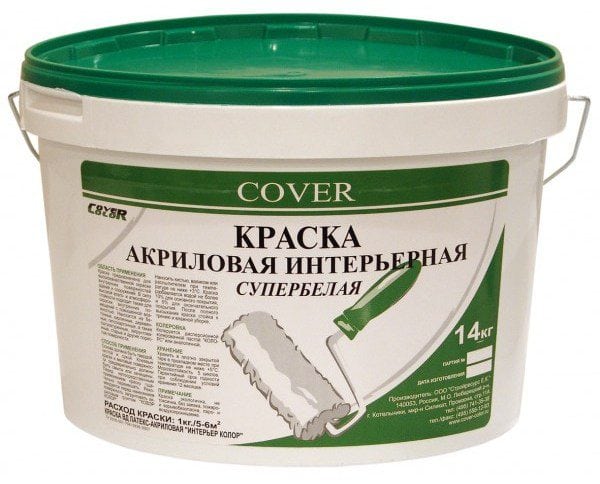Painted walls are found in almost every apartment or house. For the health of residents it is important that paints and varnishes (abbreviated as LKM) do not contain substances harmful to health. If the paint emits unpleasant odors, this is a sure sign that it contains an organic solvent that emits a lot of toxins. Odorless paint, on the contrary, contains much less undesirable substances, so its use is more justified in residential premises.
Varieties of odorless colors
Harmless paints are classified according to the basis of which they are made:
- acrylic;
- oil;
- latex;
- water dispersion.
Note! There are alkyd compounds with a faint odor. However, they cannot be called harmless, since an organic solvent is used in their production.
Each of the listed types of paints has its own characteristics, which we will consider below.
to contents ↑Oil
Oil-based formulations are distinguished by the absence of pungent odors. Oil paints and varnishes are a mixture of drying oil and pigmenting substances. Drying oil acts as a diluent.
Oil coatings can be colored or colorless. They are used both for interior and for facade work. A variety of types of materials are processed with oil paints, including metal, wood, concrete and even plaster. Often, such compositions are used for the decoration of surfaces (drawings, inscriptions, patterns).
Oil formulations are relatively inexpensive and are available to a wide range of consumers. A significant drawback of oil coatings is that they dry for a rather long time.
to contents ↑Water dispersion
The dispersion particle solvent is water. Therefore, such paints are considered safe. Water dispersion odorless floor paint always white. It is devoid of unpleasant odor, refers to quick-drying compounds and has excellent decorative characteristics. Water-dispersion coatings are water-resistant, and therefore surfaces painted with this composition can be washed without fear of damage. Since paints of this type are harmless, they can be used when painting children's rooms, rooms in hospitals and schools.
Paints of the water-dispersion group do not differ in color variety - usually they are white. However, with the help of tinting, the composition can be given the desired shade.
Waterborne coatings do not pose a risk to human skin. If necessary, wash off such paint in ordinary water, without the use of toxic solvents.
to contents ↑Note! Water-dispersion compositions have limitations on their use: they are not recommended for use for coloring heating appliances, wooden and metal products. In the latter case, it is recommended to use an odorless oil paint on metal.
Latex
Odorless latex enamel does not belong to toxic coatings, and therefore is free from unpleasant odors. Such enamel is often used when painting rooms inside buildings, it can be applied to various types of surfaces, including plaster, brick and even wallpaper.
Latex compounds are characterized by high strength, wear resistance.Due to the presence of latex in the composition, the enamel is not prone to overdrying and bloating. Odorless bathroom latex paints are moisture resistant. Such enamel can also be used for coloring kitchen rooms.
Latex enamel dries quickly: 20-30 minutes are enough for the initial drying of the surface. The final drying occurs within an hour.
to contents ↑Acrylic
Odorless paint based on acrylates is by far the most common option for painting surfaces in everyday life. They can be painted almost all types of materials. Like oil paints, acrylic coatings are often used to decorate surfaces.
Acrylic paints have many advantages:
- the complete absence of odors, since there are no toxins in their composition;
- safety for the health of builders and residents;
- fire safety;
- maximum versatility of use;
- ease of application (you can use both standard tools and textured roller to create the desired relief);
- high level of adhesive properties;
- wide color assortment;
- a variety of textures (including the creation of smooth and matte coatings);
- non-cracking coating;
- quick drying;
- good hiding power (both with and without a primer);
- resistance to abrasive loads;
- resistance to negative environmental influences (humidity, ultraviolet radiation, temperature extremes).
The disadvantage of acrylic coatings is their relatively high cost. However, due to the high operational properties, this disadvantage can be considered insignificant.
As a result of staining with polyacrylates, the surface becomes white. To give the coating a different color, it is necessary to acquire a color of the desired tonality. Kohler is added to acrylic paint in the proportion specified by the manufacturer.
In some construction supermarkets, consumers are offered the service of choosing the right color using a computer. The buyer only needs to indicate the color of paint he likes in the catalog and inform the operator of the corresponding product number. After that, the selected product of the desired color in sealed packaging is delivered to the checkout.
Acrylic coatings even during production can be equipped with special additives with antiseptic properties. Such supplements prevent the occurrence of fungus and mold. Antiseptics are especially relevant for painted wooden coatings in wet rooms.
Water-repellent and dirt-repellent substances are added to some varieties of paints. Surfaces coated with such coatings do not need frequent cleaning. In addition, the coating receives additional resistance to moisture.
to contents ↑Paint application
Below is an instruction for applying a paint and varnish material using an example of a wooden surface and acrylic paint:
- We remove dirt and dust from the tree with a brush and a damp cloth. After that, carefully dry the surface.
- We inspect the surface for the presence of tar spots. If a resin exit area is found, it must be cut to clean wood. Putty that has appeared and smooth it with sandpaper.
- If there is old paint, remove this layer, and then putty and sand the material until the surface becomes dull.
- We apply deep penetrating acrylic primer to the wood. Please note: the primer must be the same manufacturer as the paint.
- Mix the paintwork well. If necessary, dilute it with water. The permissible proportion of water is indicated by the manufacturer on the packaging (usually 5-10% of the solution volume).
- Apply paint using a brush, roller or spray. Smooth surfaces are more convenient to cover with a roller.A brush is necessary for painting hard-to-reach spots. The fastest work is with the spray, however, and the paint consumption in this case is the largest. In total, 2-3 layers of paintwork will be needed. Moreover, each subsequent layer can be applied only after the previous one dries.
Important information! Surface painting is permissible only in favorable environmental conditions. The optimum air temperature can fluctuate between 10 and 30 degrees above zero, and the humidity indicator should not be higher than 75%. Avoid direct exposure to the sun's rays on the surface to be painted. You can start full-fledged operation of the surface no earlier than a day after staining.
So, odorless paint is not fiction, it exists, and at very affordable prices. It is only necessary to choose the right coat of paint in accordance with the foundation, which will be painted. It is recommended to carefully read the instructions and carefully adhere to it when performing painting work.

